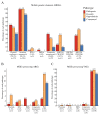Comparative analysis of Streptococcus suis genomes identifies novel candidate virulence-associated genes in North American isolates
- PMID: 35303917
- PMCID: PMC8932342
- DOI: 10.1186/s13567-022-01039-8
Comparative analysis of Streptococcus suis genomes identifies novel candidate virulence-associated genes in North American isolates
Abstract
Streptococcus suis is a significant economic and welfare concern in the swine industry. Pan-genome analysis provides an in-silico approach for the discovery of genes involved in pathogenesis in bacterial pathogens. In this study, we performed pan-genome analysis of 208 S. suis isolates classified into the pathogenic, possibly opportunistic, and commensal pathotypes to identify novel candidate virulence-associated genes (VAGs) of S. suis. Using chi-square tests and LASSO regression models, three accessory pan-genes corresponding to S. suis strain P1/7 markers SSU_RS09525, SSU_RS09155, and SSU_RS03100 (>95% identity) were identified as having a significant association with the pathogenic pathotype. The proposed novel SSU_RS09525 + /SSU_RS09155 + /SSU_RS03100 + genotype identified 96% of the pathogenic pathotype strains, suggesting a novel genotyping scheme for predicting the pathogenicity of S. suis isolates in North America. In addition, mobile genetic elements carrying antimicrobial resistance genes (ARGs) and VAGs were identified but did not appear to play a major role in the spread of ARGs and VAGs.
Keywords: Streptococcus suis; comparative genomics; pathotype; virulence-associated genes (VAGs).
© 2022. The Author(s).
Conflict of interest statement
The authors declare that they have no competing interests.
Figures





Similar articles
-
Proposed virulence-associated genes of Streptococcus suis isolates from the United States serve as predictors of pathogenicity.Porcine Health Manag. 2021 Feb 28;7(1):22. doi: 10.1186/s40813-021-00201-6. Porcine Health Manag. 2021. PMID: 33648592 Free PMC article.
-
Serotype and Genotype (Multilocus Sequence Type) of Streptococcus suis Isolates from the United States Serve as Predictors of Pathotype.J Clin Microbiol. 2019 Aug 26;57(9):e00377-19. doi: 10.1128/JCM.00377-19. Print 2019 Sep. J Clin Microbiol. 2019. PMID: 31243086 Free PMC article.
-
Genetic diversity of Streptococcus suis isolates as determined by comparative genome hybridization.BMC Microbiol. 2011 Jul 7;11:161. doi: 10.1186/1471-2180-11-161. BMC Microbiol. 2011. PMID: 21736719 Free PMC article.
-
Understanding the virulence of Streptococcus suis: A veterinary, medical, and economic challenge.Med Mal Infect. 2018 May;48(3):159-166. doi: 10.1016/j.medmal.2017.10.001. Epub 2017 Nov 6. Med Mal Infect. 2018. PMID: 29122409 Review.
-
Identification of Streptococcus suis putative zoonotic virulence factors: A systematic review and genomic meta-analysis.Virulence. 2021 Dec;12(1):2787-2797. doi: 10.1080/21505594.2021.1985760. Virulence. 2021. PMID: 34666617 Free PMC article.
Cited by
-
Molecular characterization of Streptococcus suis isolates recovered from diseased pigs in Europe.Vet Res. 2024 Sep 27;55(1):117. doi: 10.1186/s13567-024-01366-y. Vet Res. 2024. PMID: 39334446 Free PMC article.
-
Presence of Human-Associated Clade Marker Gene HAC-G19 in Streptococcus suis Isolated From Humans and Swine.Curr Microbiol. 2025 Jul 21;82(9):400. doi: 10.1007/s00284-025-04387-8. Curr Microbiol. 2025. PMID: 40690039
-
Genomic differences between sequence types 1 and 104 of Streptococcus suis Serotype 2.PeerJ. 2022 Oct 6;10:e14144. doi: 10.7717/peerj.14144. eCollection 2022. PeerJ. 2022. PMID: 36221266 Free PMC article.
-
Genomic epidemiology in Streptococcus suis: Moving beyond traditional typing techniques.Heliyon. 2024 Mar 8;10(6):e27818. doi: 10.1016/j.heliyon.2024.e27818. eCollection 2024 Mar 30. Heliyon. 2024. PMID: 38509941 Free PMC article. Review.
-
Genomic comparison of two Streptococcus suis serotype 1 strains recovered from porcine and human disease cases.Sci Rep. 2023 Apr 3;13(1):5380. doi: 10.1038/s41598-023-32724-z. Sci Rep. 2023. PMID: 37009816 Free PMC article.
References
-
- Gottschalk M, Segura M. Streptococcosis. In: Zimmerman JJ, Karriker LA, Ramirez A, Schwartz KJ, Stevenson GW, Zhang J, editors. Diseases of Swine. 11. Hoboken: Wiley; 2019. pp. 934–950.
MeSH terms
Grants and funding
LinkOut - more resources
Full Text Sources

